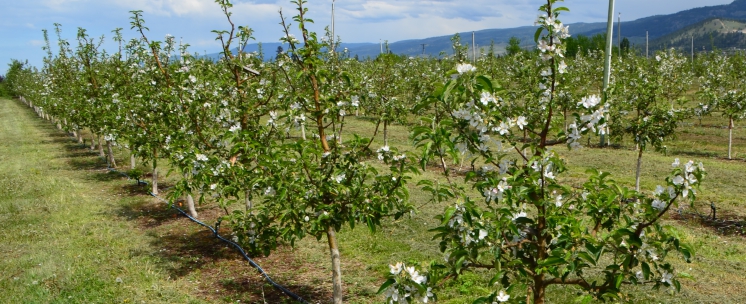-
Letters & Notices
Annual Grower MailoutEvery spring a Grower Update is prepared and sent to every orchard owner in our Program. It includes a report for each orchard showing results from the previous year, information on control measures for codling moth, news about the Program for the previous and upcoming year, and a neighbourhood map for orchard(s) showing results from the previous year. The Program Update and Neighbourhood Maps are available on our website.
-
New Orchard Notice
When new orchards are added to our Program, we send the owner a New Orchard Notice that outlines the ownership and property information of the orchard, SIR acreage, what the Program does, parcel taxation, and the appeal process for acreage changes. This notice is sent to brand new orchards, or orchards that have not been part of our Program for a while, or that may have had an ownership change.
-
Orchard to Urban Letter
This letter is sent to an orchard owner who has removed most (but not all) of their codling moth host trees. It advises that they will not be charged a parcel tax, that they are still required to maintain the trees they keep, and the changes in service that they can expect from us.
-
Schedule B - Codling Moth Control Order
These letters are printed and sent out in April to property owners that are required to remove all fruit from their codling moth host trees by June 1 of the current year.
In this case, fruit removal is not merely a suggestion – it is a legal order. The trees that require this action (whether all or only some) are listed on the order. Pruning the tree and opening up the canopy is a good way to remove some of the fruit, and then the remaining buds will need to be removed as well. The buds are easier to find when the petals are in bloom, but the bud itself needs to be removed – not just the petals. Hard pruning the tree will remove the most fruit and make it easier to remove it the next year as well.
Codling moths need the fruit in order to complete their lifecycle – this is why stripping the fruit is such an effective method for codling moth control. Even when the moths emerge from overwintering and mate and lay eggs, if the larvae have nothing to feed on then they will starve. Stripping is usually required for at least a couple of years, as some larvae may remain dormant for an extra year or two.
During re-inspection, if we find that the resident has not stripped the required tree(s) then a reminder will be given. If the resident refuses to comply then SIR will be required to strip the fruit for them at a rate of $50 per man hour (as set by the Board) and also possible charges for disposing of the fruit – infested fruit must be properly disposed of.
If the fruit is stripped too late or apples are missed then there is higher risk of infestation continuing. Those that strip their fruit completely and by/before the required deadline are more likely to go back to growing fruit sooner than those that don’t (because those that don’t are at higher risk for continued infestation).
This order can not be appealed.
-
Schedule A - Warning Notice
Property owners can receive this warning notice at any time if a codling moth infestation has been found on your property. This letter requires property owners to remove all fruit from their codling moth host trees.
This is like a Schedule B as it requires the grower to strip the fruit from their host trees; however, this strip order is issued by staff if they determine in the middle of the season that a tree has too high a level of infestation. Growers are given roughly a week or so to have all of the fruit removed from the tree(s).
-
Schedule D - Codling Moth Host Tree Removal Order
This is a tree removal order – the last resort. It is a priority to work with growers to prevent and remove codling moth infestation, but if there is an unacceptable history of codling moth infestation and it seems that the trees will continue to remain in such a state, then this order, and a legal package, may be issued by a Compliance Officer. The schedule is usually delivered in person so that we know that they have received it. Once the schedule is issued the owner has a week to either remove the tree(s) as ordered, or make an appeal.
If the grower chooses to appeal the tree removal order, then they will need to fill out and return to us a Schedule F within seven days. They will then be invited to appear before the SIR Board to present their appeal. The Board will then decide whether or not the tree(s) will be removed.

